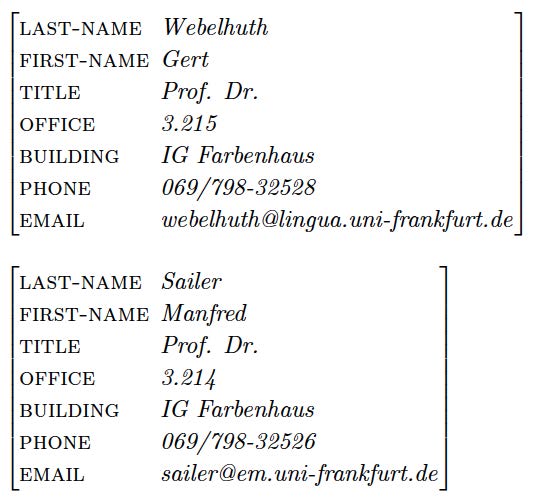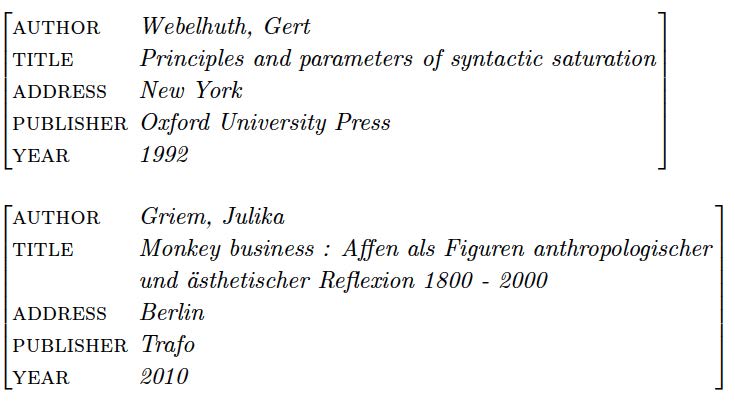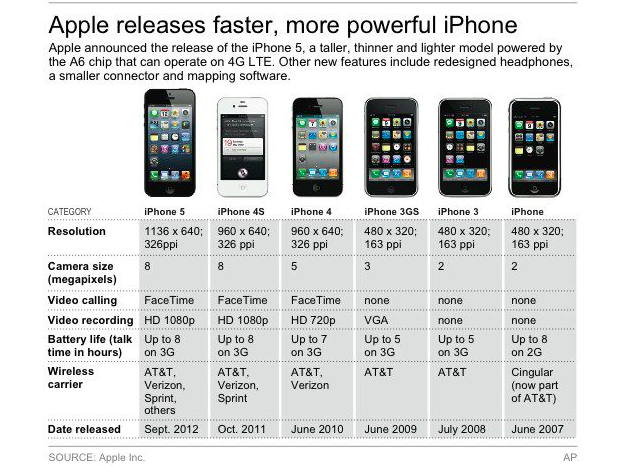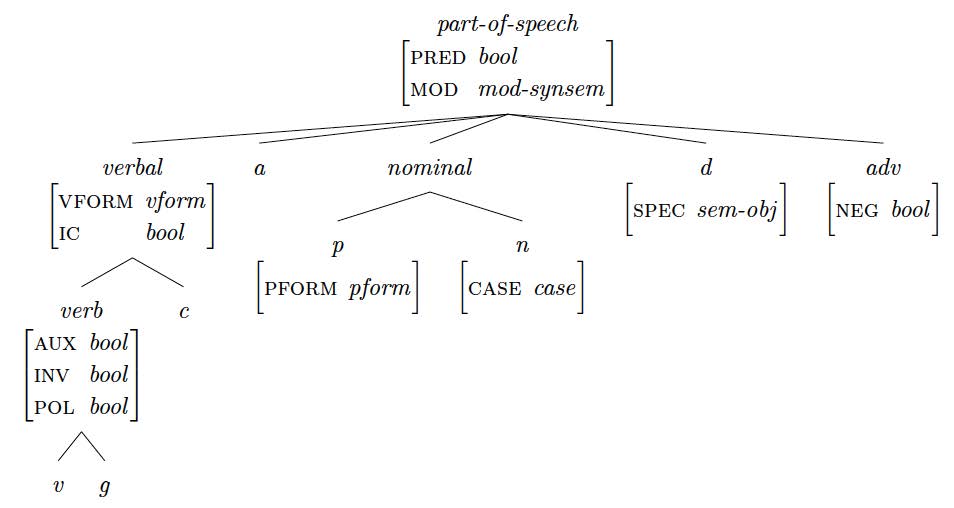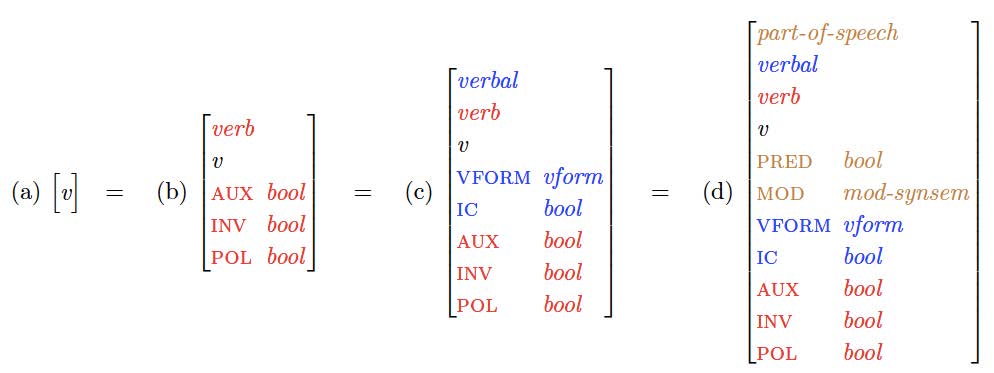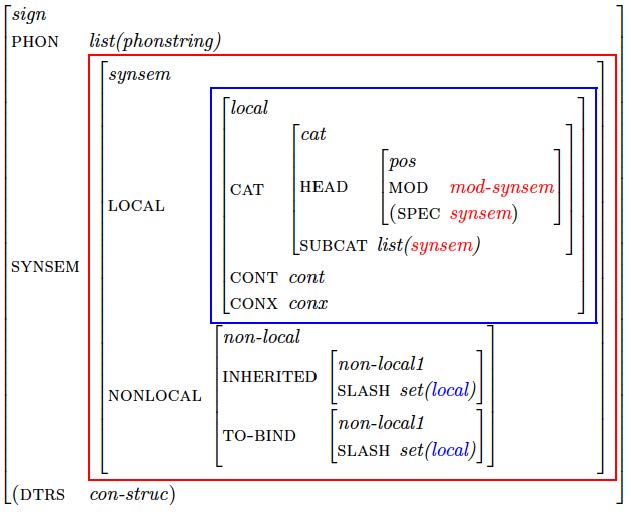|
|
| (36 intermediate revisions by the same user not shown) |
| Line 1: |
Line 1: |
| == Syntax 1 Wiki ==
| | [[Syntax_1_Wiki|Syntax 1 Wiki]] |
|
| |
|
| | [[Constraint-based_Syntax_2|Syntax 2]] |
|
| |
|
| <font face="Arial, Helvetica, sans-serif">
| |
| <font size="3">
| |
|
| |
|
|
| |
|
| | [[Grammar-Writing|Grammar Writing]] |
|
| |
|
| [[Words|Words]] | | [[GS-2000|Ginzburg and Sag (2000)]] |
|
| |
|
| ==Conjunctions==
| | [[HPSG|Head-Driven Phrase Structure Grammar]] |
| Subclasses:
| |
| Coordinate conjunctions:
| |
| examples:
| |
| simple coordinate conjunctions: and, or, but
| |
| complex coordinate conjunctions: either ... or, neither ... nor
| |
| coordinate conjunctions link two phrases of the same type.
| |
| Subordinate conjunctions:
| |
| examples: since, because, while, although, when, before, after, until, unless, as, if
| |
| Difference between coordinate and subordinate conjunctions:
| |
| Pat went to the theater and Chris stayed home.
| |
| * And Chris stayed home Pat went to the theater.
| |
| Pat went to the theater while Chris stayed home.
| |
| While Chris stayed home, Pat went to the theater.
| |
| Complementizers are syntactically similar to subordinate conjunctions.
| |
|
| |
|
| ==Complementizers==
| | [[Syntax_1_Wiki_Aenderungen|Syntax 1 Wiki: Änderungen]] |
| Introduce complement clauses
| |
| Examples:
| |
| introduce finite complement clauses: that (declaratives), if/whether (interrogative)
| |
| Pat thinks [that Chris lives in New York].
| |
| Pat knows [that/whether Chris lives in New York].
| |
| Pat wonders [if/whether Chris lives in New York].
| |
| introduce infinitival complement clauses: for
| |
| Pat wants [for Chris to win the price].
| |
|
| |
|
| ==Particles==
| |
| Particles usually have the same form as prepositions
| |
| Examples: call sth. off, look sth. up
| |
| characteristics:
| |
| Particles combine with certain verbs to form non-predictable and mainly idiomatic particle verbs.
| |
| They contrast from prepositions in that they are more flexible:
| |
| 'V Part NP' and 'V NP Part' are both possible (The umpire called off the game., The umpire called the game off)
| |
| For prepositions, only 'V P NP' is possible (The teacher fell off the chair, *The teacher fell the chair off.)
| |
| When the NP is a pronoun, only 'V Pron Part' is possible (The umpire called it off/ *off it.). This ordering is excluded for prepositions (*'V Pron P', *The teacher fell it off.)
| |
|
| |
|
| ==The Infinitival Marker to== | | <center> |
| General characteristics:
| | <embedvideo service="youtube" dimensions="400">https://www.youtube.com/watch?v=JRiX8Jiq_Z4</embedvideo> |
| Infinitival to precedes a base form verb.
| | </center> |
| The distribution is like that of auxiliaries, but in infinitival clauses:
| |
| position between the subject and the verb phrase
| |
| It is crucial [for John to show an interest].
| |
| It is crucial that John should show an interest.
| |
| ellipsis
| |
| I know I should [go to the dentist’s], but I just don’t want to.
| |
| I don’t really want to [go to the dentist’s], but I know I should.
| |
|
| |
|
| ==The Negative Marker Not==
| |
| Can follow a finite auxiliary to negate a sentence, but not a finite verb.
| |
| I should not have said that.
| |
| * I not slept well last night.
| |
| Can precede any major phrase for so-called constituent negation.
| |
| NP: Pat read not [NP: this book] but the other one.
| |
| VP: Chris is likely not [VP: to get the scholarship]
| |
| PP: Sandy put the book not [PP: on the shelf] but next to it.
| |
| Forms: not, n't (when cliticised to an auxiliary)
| |
|
| |
|
| | [ Parts of the clause] |
|
| |
|
| | <!-- This is a comment --> |
| | ∀''x'' ('''cat'''(''x'') : ∃''y''('''likes(''y'', ''x'')) |
| | ⊃ ∧ ¬ ∨ ≡ ∀ ∃ æ ⊕ Ø ⇒ <u>Unterstrichen</u> → ⇒ |
| | |
| | Text davor |
| | <blockquote>Blockquote</blockquote> |
| | Text danach |
|
| |
|
|
| |
|
|
| |
|
| | <font face="Arial, Helvetica, sans-serif"> |
| | <font size="3"> |
|
| |
|
| | Font size 3 |
|
| |
|
| | </font> |
|
| |
|
| | <span style="color: red>Text color</span> |
|
| |
|
| | [<sub>NP</sub> labeled brackets ] |
|
| |
|
| <quiz display=simple> | | Superscripts<sup>1</sup> |
| {Determine the part of speech of the words in the sentence.<br /> Use the following part of speech labels: A, Adv, Cj, C, D, N, P, V
| |
| |type="{}"}
| |
| | |
| Alex/{ N _5 } talked/{ V _5 } to/{ P _5 } my/{ D _5 } best/{ A _5 } friend/{ N _5 }.
| |
| || Solution: N V P D A N
| |
| </quiz>
| |
| | |
| <quiz display=simple>
| |
| {Determine the part of speech of the words in the sentence.<br />Use the following part of speech labels: A, Adv, Cj, C, D, N, P, V
| |
| |type="{}"}
| |
| | |
| You/{ N _5 } might/{ V _5 } suspect/{ V _5 } that/{ C _5 } Pat/{ N _5 } is/{ V _5 } a/{ D _3 } genius/{ N _5}.
| |
| || Solution: N V V C N V D N
| |
| </quiz>
| |
| | |
| <quiz display=simple>
| |
| {Determine the part of speech of the words in the sentence.<br />Use the following part of speech labels: A, Adv, Cj, C, D, N, P, V
| |
| |type="{}"}
| |
| | |
| The/{ D _5} title/{ N _5 } of/{ P _5 } a/{ D _5 } book/{ N _5 } largely/{ Adv _5 }
| |
| || Solution: D N P D N Adv V
| |
| | |
| determines/{ V _5 } whether/{ C _5 } it/{ N _5 } will/{ V _5 } be/{ V _5 } successful/{ A _5 } or/{ Cj _5 } a/{ D _5 } flop/{ N _5 }.
| |
| || Solution: V C N V V A Cj D N
| |
| </quiz>
| |
| | |
| === Semantic analysis of sentences into predicates and arguments ===
| |
| | |
| Note: Many of the sentences in this section are taken from or based on examples in Hornby, A.S. (1975) Guide to Patterns and Usage in English. Second Edition. Cornelsen & Oxford University Press.
| |
| | |
| <quiz display=simple>
| |
| { Fill in the gaps!
| |
| | |
| ''Example:'' <span style="color: blue>You <u>surprised</u> them.</span>
| |
| | type="{}" }
| |
| | |
| Predicate: { x surprises y _15}
| |
| | |
| x = { You _10}
| |
| y = { them _10}
| |
| z = { - _10}
| |
| </quiz>
| |
| | |
| <quiz display=simple>
| |
| { Fill in the gaps!
| |
| | |
| ''Example:'' <span style="color: blue>We went to Wales.</span>
| |
| | type="{}" }
| |
| | |
| Predicate: { x goes y _15}
| |
| | |
| x = { We _10}
| |
| y = { Wales _10}
| |
| z = { - _10}
| |
| </quiz>
| |
| | |
| | |
| <quiz display=simple>
| |
| { Fill in the gaps!
| |
| | |
| ''Example:'' <span style="color: blue>The plane landed.</span>
| |
| | type="{}" }
| |
| | |
| Predicate: { x landed _15}
| |
| | |
| x = { The plane _10}
| |
| y = { - _10}
| |
| z = { - _10}
| |
| </quiz>
| |
| | |
| <quiz display=simple>
| |
| { Fill in the gaps!
| |
| | |
| ''Example:'' <span style="color: blue>Steven met my most favorite teacher.</span>
| |
| | type="{}" }
| |
| | |
| Predicate: { x meets y _15}
| |
| | |
| x = { Steven _10}
| |
| y = { my most favorite teacher_30}
| |
| z = { - _10}
| |
| </quiz>
| |
| | |
| <quiz display=simple>
| |
| { Fill in the gaps!
| |
| | |
| ''Example:'' <span style="color: blue>She said that it would rain.</span>
| |
| | type="{}" }
| |
| | |
| Predicate: { x says y _15}
| |
| | |
| x = { She _10}
| |
| y = { that it would rain _25}
| |
| z = { - _10}
| |
| </quiz>
| |
| | |
| <quiz display=simple>
| |
| { Fill in the gaps!
| |
| | |
| ''Example:'' <span style="color: blue>Many of his friends consider Joe somewhat arrogant.</span>
| |
| | type="{}" }
| |
| | |
| Predicate: { x consider y z _15}
| |
| | |
| x = { Many of his friends _25}
| |
| y = { Joe _10}
| |
| z = { somewhat arrogant _20}
| |
| </quiz>
| |
| | |
| | |
| <quiz display=simple>
| |
| { Fill in the gaps!
| |
| | |
| ''Example:'' <span style="color: blue>We need to talk to Lilly about her behavior.</span>
| |
| | type="{}" }
| |
| | |
| Predicate: { x talk y z _15}
| |
| | |
| x = { We _10}
| |
| y = { to Lilly _10}
| |
| z = { about her behavior _20}
| |
| </quiz>
| |
| | |
| <quiz display=simple>
| |
| { Fill in the gaps!
| |
| | |
| ''Example:'' <span style="color: blue>The plane landed.</span>
| |
| | type="{}" }
| |
|
| |
|
| Predicate: { x lands _15}
| | Definitionsliste: |
|
| |
|
| x = { The plane _10}
| | ;Begriff 1 |
| y = { - _10}
| | : Beschreibung 1 |
| z = { - _10}
| | ;Begriff 2 |
| </quiz>
| | : Beschreibung 2-1 |
| | : Beschreibung 2-2 |
|
| |
|
| | Text einrücken: |
|
| |
|
| <quiz display=simple>
| | : Einfache Einrückung |
| { Fill in the gaps!
| | :: Doppelte Einrückung |
| | ::::: Mehrfache Einrückung |
|
| |
|
| ''Example:'' <span style="color: blue>I talked to her.</span>
| | Nummered list: |
| | type="{}" }
| |
|
| |
|
| Predicate: { x talks y _15}
| | # Erstes Element der ersten Ebene |
| | ## Erstes Element der zweiten Ebene |
| | ## Zweites Element der zweiten Ebene |
| | # Zweites Element |
|
| |
|
| x = { I _10}
| | Bulleted lists: |
| y = { to her _10}
| |
| z = { - _10}
| |
| </quiz>
| |
|
| |
|
| | * Erstes Element der ersten Ebene |
| | ** Erstes Element der zweiten Ebene |
| | ** Zweites Element der zweiten Ebene |
| | * Zweites Element |
|
| |
|
| <quiz display=simple>
| |
| { Fill in the gaps!
| |
|
| |
|
| ''Example:'' <span style="color: blue>We gave Lilly a bike.</span>
| |
| | type="{}" }
| |
|
| |
|
| Predicate: { x gives y z _15}
| |
|
| |
|
| x = { We _10}
| | [[File:employees.jpg]] |
| y = { Lilly _10}
| | [[File:books.jpg]] |
| z = { bike _10}
| | [[File:iphones.png]] |
| </quiz>
| | [[File:pos-jpg.jpg]] |
| | [[File:pos-v-1.jpg]] |
| | [[File:pos-v-2.jpg]] |
|
| |
|
| <quiz display=simple>
| |
| { Fill in the gaps!
| |
|
| |
|
| ''Example:'' <span style="color: blue>Someone pushed Lilly into the flowers.</span>
| |
| | type="{}" }
| |
|
| |
|
| Predicate: { x pushes y z _15}
| |
|
| |
|
| x = { Someone _10}
| |
| y = { Lilly _10}
| |
| z = { into the flowers _20}
| |
| </quiz>
| |
|
| |
|
|
| |
|
